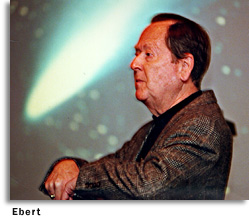 Ebert discussed asteroids, meteors and other celestial bodies in a
lecture titled "Asteroids: A Menace from Space," presented April 17 as
part of the UB at Sunrise series of breakfast lectures.
Ebert discussed asteroids, meteors and other celestial bodies in a
lecture titled "Asteroids: A Menace from Space," presented April 17 as
part of the UB at Sunrise series of breakfast lectures. 
They're asteroids, and according to Charles H.V. Ebert, SUNY Distinguished Teaching Professor in the Department of Geography, the possibility that the Earth will be hit by one "exists 24 hours a day."
 Ebert discussed asteroids, meteors and other celestial bodies in a
lecture titled "Asteroids: A Menace from Space," presented April 17 as
part of the UB at Sunrise series of breakfast lectures.
Ebert discussed asteroids, meteors and other celestial bodies in a
lecture titled "Asteroids: A Menace from Space," presented April 17 as
part of the UB at Sunrise series of breakfast lectures.
"We all have the illusion of empty space....We have to understand the space around us is full of natural material and space junk," he said.
And that natural material and space junk isn't just whizzing past us. Earth is bombarded by 500,000 visible meteors-and three to four 10-pound meteors-every day. A five-ton meteor hits the Earth's atmosphere each month, a 50-ton meteor hits every 30 years, a 250-ton meteor every 150 years, and a 50,000-ton one every 100,000 years.
"The good news is, thanks to our atmosphere, when they fall to earth they burn up," Ebert said. "These things are there and they're going to hit."
In fact, Earth had a near miss 25 years ago when an asteroid named Hermes, estimated at 38 feet in diameter and 1,000 tons, came within 37 miles of the planet on Aug. 10, 1972. Fortunately, its trajectory was too flat and the asteroid bounced off the earth's atmosphere like a stone skipping across water.
But when asteroids strike the earth, "they hit like an artillery shell," Ebert said, colliding with the planet at a velocity of 16-20 km/second. The result is a crater, formed by enormous compression-as much as 750,000 to 15 million pounds per square inch-and enormous heat that vaporizes the asteroid.
There are about 70 known craters on earth. Perhaps the best known is the Berringer crater in Arizona. A lesser-known crater was formed in Russia in 1908, and according to witnesses, the sound of the asteroid hitting the earth was audible for more than 600 miles. Indeed, if the asteroid had fallen five hours earlier, the city of St. Petersburg would have been incinerated, Ebert said.
So what would happen if an asteroid struck a little closer to home?
"If a full-fledged asteroid hit Buffalo, the destruction would extend 1,000 miles and nothing would be left standing.
"And I'm sure classes at UB would be canceled," Ebert quipped.
Hale-Bopp has generated a lot of interest in comets, which, Ebert noted, are very different from asteroids. While asteroids are composed primarily of stone-like and/or metallic material, comets are more like a dirty snowball, composed of ice and gases, such as methane and carbon dioxide.
This nucleus is solid, but begins to vaporize as the comet is struck by solar light and solar wind, forming the tail that reflects the light from the sun and the glow of ionization. Ebert shared a point of interest about the tails of comets: they point directly to the place where the sun has set.
"The universe puts on a fine show, and as long as we put ourselves at the center of the universe, we should enjoy the show," Ebert said. n